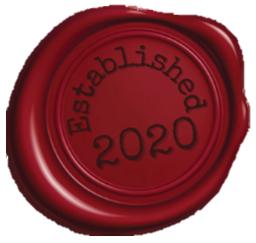Basics Section
Okay, are you ready? It’s time to really get our hands dirty! Let’s get started with the Basics tab. In this section, we will cover Account Logins and Passwords, as well as Assets, Liabilities, and Other Accounts. This was probably the section I dreaded creating the most, but it will really save you some major headaches in an emergency.
Account Logins and Passwords
For this document, I really encourage you to take the time to think through everything that you log in to and provide that information. You could choose to exclude the smaller, less important things such as social media if you want. I chose to include them on mine, in order to have a full and complete list.
Because this document will contain very sensitive information (as will other documents we create for this binder), you will want to make sure you keep it as protected as possible. Don’t let just anyone know you have it or where you keep it. Only tell those closest to you who you know without doubt you can trust where you keep your binder. In addition, if you keep a copy of this document on your computer, I strongly suggest making it a password-protected document—just don’t forget the password to access it!
Another suggestion is to organize your logins with some rhyme or reason. One suggestion is to clearly separate your personal logins from your business logins, or possibly separate each person. In the example below (all secure information has been changed, of course), you’ll notice that I have a highlighted heading for personal and business logins. Another suggestion would be to list them in some sort of order. On my actual Account Logins and Passwords document, I started with our basic logins (like for the computer and our phones), before extending into what I deemed the most important logins (like our bank and credit card), and eventually working my way down to the least important logins (like social media and streaming services).
Consider the following logins and passwords for both personal accounts and business accounts:
- computer password
- phone passcode
- online banking
- insurance (auto, homeowner’s/renter’s, medical, etc.)
- credit cards
- any other billers you pay or access online
- email (business and personal)
- memberships or subscriptions (e.g.: Amazon, Costco, magazines, business associations, etc.)
- streaming services or entertainment (e.g.: Netflix, Disney+, Hulu, Amazon Prime, etc.)
- social media (e.g.: Facebook, Instagram, Snapchat, Pinterest, LinkedIn, etc.)
- cloud drives (e.g.: iCloud, Google Docs, Dropbox, etc.)
- chip registration websites for your pets
- websites or apps related to your job
- college or school websites

This list will take you some time to create, and you likely will return to it here and there because you suddenly remember something you left off or you create a new account or change a password. Saving this document to your computer, a thumb drive, or a cloud drive is a wise idea and makes for easy changes, just remember to make it a password-protected document. You can organize this list in any way you like. I chose to do two columns (on Word, choose the Layout tab, then select however many columns you would like) and organized it into categories (Personal and Business).
Assets and Liabilities
This next list takes time and patience to create as well, but it will make keeping up with the bills much easier for anyone who suddenly has to take over. In my family, I’ve always been the one to handle our finances—it’s just the natural role I fell into since I had my own checking account since I was sixteen. My husband and I are both okay with this arrangement. The only problem is, because my husband doesn’t check our bank account much or balance the checkbook very often, he is minimally aware of our general financial status. So, what if I were to fall ill or have a crazy accident? How would he even know where to even begin with maintaining the regular bills and finances? Would he even know how to log in to our online banking? In such a scenario, this list would be invaluable for him or anyone else who may suddenly need to take on this role.
Assets
Under assets, list everything you own whether it is liquidated (cash) or not (objects). Here are some things to include in your list of assets:
- bank name, phone number, routing number
- checking account (include account number)
- savings account (include account number)
- UTMA (aka: child savings account) account (include account number)
- IRA account (include account number)
- investment company, phone number
- vehicle: year, make, model, trim level (include all vehicles you own as a separate bullet point, including recreational vehicles such as trailers) and don’t forget to include pertinent details, such as if you still owe on it (and to what company) or have the title, number of owners the vehicle has had, stock or custom parts, fuel type, transmission type, plate number, VIN number, etc.
- animals/pets: include their name, breed and type of animal, color/markings, birth year, chip number (if applicable), any other pertinent details about them, and their care instructions (medications, food type and amount, vaccinations, regular health visits, etc.)
Be sure to list account numbers and consider including phone numbers for easy contact as well. Be as detailed as possible for items such as vehicles and animals (I wrote these items up as though they were sale ads).

Be sure to be as detailed as possible for your vehicles (this includes recreational vehicles). This will help in the instance of your death. The person reading it will be able to sell your vehicles if necessary and use the money to pay for funeral expenses or any remaining debt. (The examples below are entirely made up and do not reflect my actual vehicles.)

Just like the vehicles, be sure to be as detailed as possible when listing your animals as well. This will assist in finding them new homes and ideally continuing the same level of care that you provided for them. (The example below is made up and does not reflect my actual horse.)

Liabilities
For your liabilities, be sure to list every company or individual you owe money to, whether it’s a regular monthly bill or a loan. Here’s a list of some items you should consider including:
- mortgage
- property taxes (if they are included with your mortgage payment, mention this fact)
- loans (equity, auto, personal, business, etc.)
- credit cards
- medical (doctor or hospital bills you are making payments on)
- utilities (gas/electric, water, garbage, sewer, etc.)
- internet provider
- landline provider (if applicable)
- mobile phone provider
- insurance (medical, auto, homeowner’s/renter’s, etc.)
- entertainment (Netflix, Disney+, Hulu, etc.)
- paid memberships or subscriptions (Costco, Amazon, magazines, etc.)
Include account numbers and consider including phone numbers as well for easy contact. This will allow whoever takes over your estate to cancel any unnecessary services, close accounts (remember there are certain legal processes for closing some accounts, like at the bank), and/or ensure timely payments for continuing debts.


Phew! You’ve got some hard work ahead of you, but trust me, it is so worth it to have this section completed.
I recommend that you check over everything and perform updates at least twice a year, but the more often you do this, the less time it’ll take and the more reliable it’ll be in an emergency. Personally, I add new accounts to the list every time I create one, but I only print a new copy twice a year. Consider setting a reminder in your calendar to do this and be sure to note somewhere on the page the last updated date.You could also make a note on this document to check the computer for the most current version (if you choose to keep a copy on there). If you do, be sure to explain where exactly to find it on the computer.
Next Time…
…we will cover the Child(ren) Section. Even if you don’t have small children, there is still one section here that will apply to you. See you soon!



Great info!
Thank you!
Great information. Thanks for providing all of this.
I’m glad you are finding it useful. 🙂